Go the distance with these fun measurement activities!
Posted by Remya Padmadas on March 02, 2016If you thought your friend's house on the other side of town was far away, you have clearly not read this book. Climb the Magic Math Ladder to get from where you are to the top of Mount Everest, to Kashmir, to the moon, the Sun, and ultimately, to the edge of the Universe, which is very, very, VERY far away indeed. Ready, steady, go!
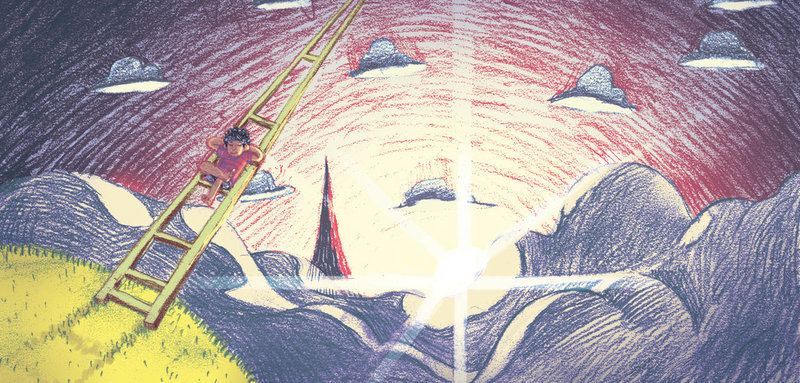
ACTIVITIES
Use Your Body
Resources
-
A Metre scale or strips of newspaper cut and taped together into meter long strips
What to do
-
Find something long to measure. It could be a boundary wall, the length of garden pathway - anything you like!
-
First ask the children to lie down head to toe, one after the other along the length of the item and find out how many ‘children’ it takes to measure the wall.
-
Next, ask them to measure the same distance with their metre long strips of newspaper.
-
What’s the difference in the measurement? Talk about how it’s important to have a standardised unit of measurement!
Globe Guesstimate!
Resources
-
Globe
-
Google
Ask the children to pick any two places on the globe and guesstimate how far apart they are. Then use Google to find the correct answer.
The closest guestimates win a prize!
comment (1)On translating children's books: A Google Serve volunteer's story
Posted by Remya Padmadas on January 06, 2020Karthigeyan Sivaraj is a Google Serve campaign volunteer who has worked with StoryWeaver to help translate several storybooks into Tamil, including I Can Climb! and My Best Friend.
In this Q&A, Karthigeyan shares his experience about translating on StoryWeaver, his insight into the translation process, and his love for children's literature.

Q: Do tell us a little bit about yourself, your interests, your work
I'm a Googler by profession and by practice, and I'm proud of that! At work, being a Googler means respecting my colleagues and welcoming their opinions and ideas, howsoever different they may be to my own, and keeping things necessarily simple to my stakeholders, and I attempt to do the same outside the walls of my office as well. Having learned how to analyze data on the job, I brand myself as a data story-teller - i.e., processing data and presenting meaningful information in a way that pushes the audience to take the desired action. The interesting aspect of my job is that it allows me to improve the existing processes through imaginative ways and take ownership of some of the workflows in my organisation, thereby ensuring candidates joining Google have a lasting positive impression about their onboarding experience.
Q: Do you remember the first time you heard about StoryWeaver? What are your thoughts about the platform?
Of course, it's quite vivid in my memory the first time I heard about StoryWeaver. The concept of weaving children's stories is quite dear to my heart, and it's really gladdening to see the team working behind crafting stories as well as making them available in multiple different languages for the young audience to read and relish. I personally nurtured a similar idea a few years ago when I was an avid blogger but didn't have the imaginative power nor the enterprising capabilities to venture into this domain - I was really happy to find the StoryWeaver team doing some marvellous work in this field. Kudos to all!
Q: What was your experience of the GServe campaign, and translating books with fellow Google volunteers?
It's always a very humbling experience to take part in any GServe campaign, no matter what the cause that's being championed. The StoryWeaver campaign was very well thought through in many ways - for one, it didn't require us to sacrifice the luxury of our desks and we could contribute while at work or on the move. It was also so much fluid socializing with fellow Googlers who were taking up similar translation work. Overall, it was a rewarding experience to be able to contribute our might in little ways possible to make a huge change!
Q: We are so glad that you came on board as a commissioned translator even after the GServe campaign! What prompted you to stay in touch?
As I had mentioned previously, contributing to children's literature was always dear to me, and when I got to know about StoryWeaver's mission and their robust infrastructure, I felt relieved knowing that I didn't have to worry too much about the modus operandi, but rather focus on the work itself. With a major piece of work shouldered by the StoryWeaver team, I wanted to work with the team even after the GServe campaign, so that I could do what I like to do - writing, crafting and translating.
Q: What was your experience of being a commissioned translator? Did you pick up any new tips and techniques?
A lot I must say! One very important technique I adopted pretty early on was that I realized that translating the original work into the language of my preference required knowing the cultural nuances deeply. For instance, while translating a story from English targeting the Hindi speaking audience and translating it into Tamil would mean we will have to take into account the various cultural aspects such as the equivalent idioms used in the region. Internalizing all these cultural & regional nuances in the local language while translating is imperative if the audience has to relate to the stories. Else, they wouldn't 'stick'!
Q: How tricky is it to translate stories to Tamil? Are there any phrases that you particularly spent time on because they were difficult to translate?
Tamil, for all its richness, is a very unique language in that there are several different dialects in use across the Tamil diaspora. It becomes even trickier when you realize that the written form of the language is very different to the conversational style, and even the conversational style assumes a different shade when it comes to young audiences. Stories will have to be narrated to children in a style that's neither too formal nor too conversational and we should be ready to use a few English words that are in daily use, so they can relate to them. Also, unfortunately, tools such as Google Translate provide very literal translations of phrases which is sometimes very challenging even to the mature audience, hence you have to take a judgement call based on your own intuition and observation. I bet this is true for many Indic languages!
Q: What has been your favourite book to translate on StoryWeaver?
That's a tough one! Each of the books takes you down memory lane and makes you relive your childhood :) Be it Rani's First Day at School or the restless lad who couldn't wait to open this birthday gifts the next day or the fearless little girl - each provides a glimpse of your own childhood. For the sake of picking one, I would go for I Can Climb! which is packed with a lot of positive self-talk for young kids who are taking baby steps as they encounter different activities for the very first time in their lives.
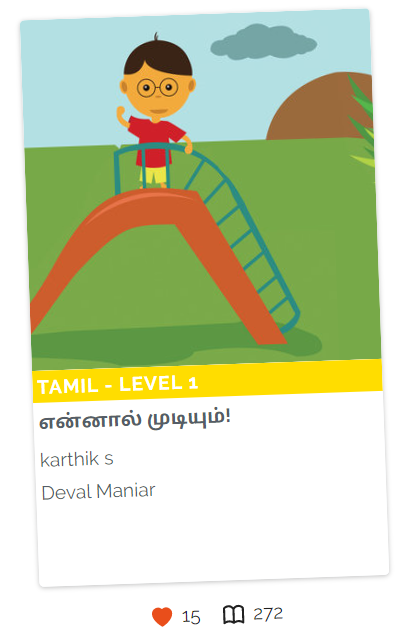
Q: What are some of your favourite books from childhood? Is there any memorable reading moment that you would like to share?
I relished reading across different genres in both English and Tamil. In Tamil literature, especially that was taught to us in school, all messages were delivered in a cryptic fashion replete with metaphors and similes. That allowed for deep learning, situational paraphrasing and lateral thinking. For that very same reason, I preferred the works of John Milton, Rudyard Kipling & John Keats in English and innumerable poets in Tamil.
As a kid, I was an avid read of Tinkle Kids' magazines, and I used to eagerly await the next monthly edition. I am really glad to see that same level of curiosity now possessed by my niece. It seems the magazine hasn't lost its attractiveness to date!
Q: The translations you have contributed to our platform have been read over 1800 times - thank you! How has your StoryWeaver journey been? What is one big takeaway from this experience?
The biggest takeaway for me has been that we shouldn't shy away from walking in the little shoes of our young audience to truly understand what holds their curiosity and interest. Many a time, we - adult learners - tend to wear our own caps, and view children's literature in a rather lop-sided manner. However, we should be ready to speak the language of the kids (sometimes even practise prattling), simplify the language (without over-simplifying at the cost of losing the essence) to suit them and be more imaginative (what helped me to feel the pulse of the audience was to subject my work to, what I like to call, the 'niece'-test - i.e., talking to my nieces and having them vet some of my initial works)
Do leave your thoughts in the comments section below. You can also reach out to us through our social media channels: Facebook, Twitter and Instagram.
Be the first to comment.The Asia Foundation: Taking joyful stories to children in Developing Asia
Posted by Remya Padmadas on February 20, 2017The Asia Foundation is an international nonprofit that helps societies work towards a peaceful, just, and thriving region, and currently works to improve the standard of living across Asia, from Sri Lanka to Mongolia. Improving literacy levels is integral to the work the organisation does, and they have spearheaded a number of programmes across the region to this end.
One such initiative is Let’s Read! which pledges to provide storybooks to children across the continent. “Through technology initiatives and book donations, we help infuse students with a love of reading essential for literacy,” says Melody Zavala, director of the Books for Asia program at The Asia Foundation.
As part their Let’s Read! campaign, The Asia Foundation has created e-libraries that are accessible on any device. "The e-library works in low-bandwidth environments and doesn't require an active internet connection for reading and hence are able to reach children even in areas with poor bandwidth and infrastructure. Books available are in the mother tongue languages of the children. “We know that children learn first and best in their mother tongue. So we want to make local publications available to more children and stimulate their imagination in ways that can only be possible in a local context,” commented Melody.
To provide a wide range of these books, The Asia Foundation used the vast collection of stories available on StoryWeaver. “The translate tool on StoryWeaver attracted us, as once a language (e.g. Thai) is available on the platform, we can get stories translated and provide a large number of quality children’s literature to our partner schools,” shared Melody.
Being able to draw on StoryWeaver titles has been invaluable to the Let’s Read! initiative, shares Melody. The initiative incubates innovative digital, print, and community-based solutions to "improving access to high-quality children’s books in mother tongues and national languages and currently consists of integrated e-book library, translation, and content creation projects.
Stories in Khmer
“So far, we’ve translated 9 titles into Khmer which are all available on StoryWeaver. The stories are also available on our Cambodia project site, along with new stories created in Khmer by local authors and illustrators during our e-book hackathons." informed Melody. "In Cambodia the Ministry of Education’s online education portal will also link to these stories, hence making them available to their 1.5 million followers. he stories will also be made to other Khmer educational apps and projects, including Khmer LEARN, which has 38,000 users, and the Library For All app, which is used in 5 rural schools
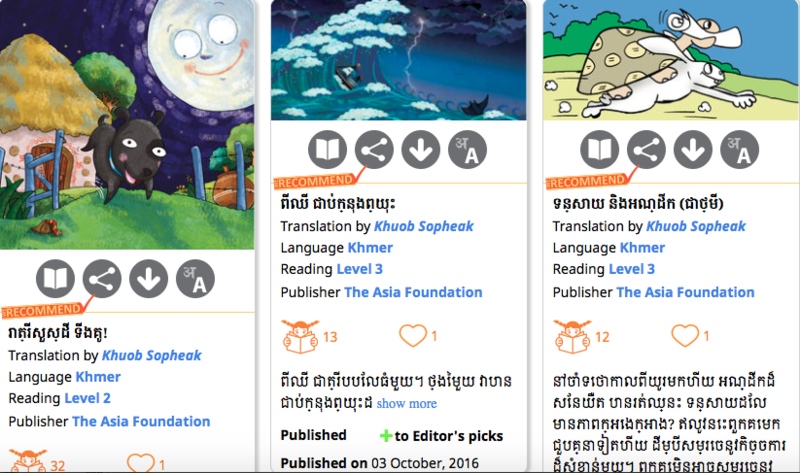
Increasing content in ethnic minority languages
In Thailand, StoryWeaver content will be translated as a part of the Let’s Read initiative there that utilizes a suite of integrated smartphone apps – a translation tool and free story reader app - to increase content in ethnic minority languages. A Let’s Read! translation workshop took place in Chiangmai, Thailand where 10 Pratham Books titles from StoryWeaver were translated from Thai into S’gaw Karen. The programme will initially be implemented in 10 villages and positively impact 1,000 children. S'gaw Karen is spoken by over four million S'gaw Karen people in Burma, and 200,000 in Thailand. The Asia Foundation will be using their own Thai translations on StoryWeaver to create joyful reading material in S'gaw Karen. Content translation for programmes in Bangladesh has also been initiated."
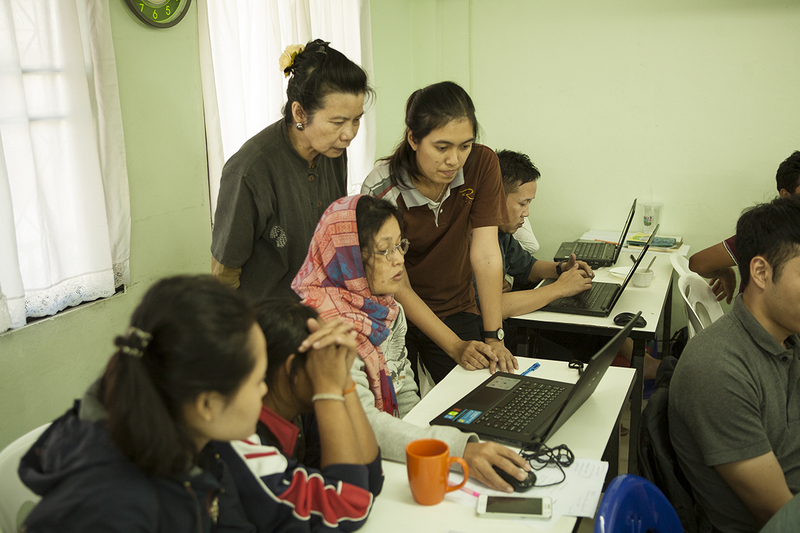
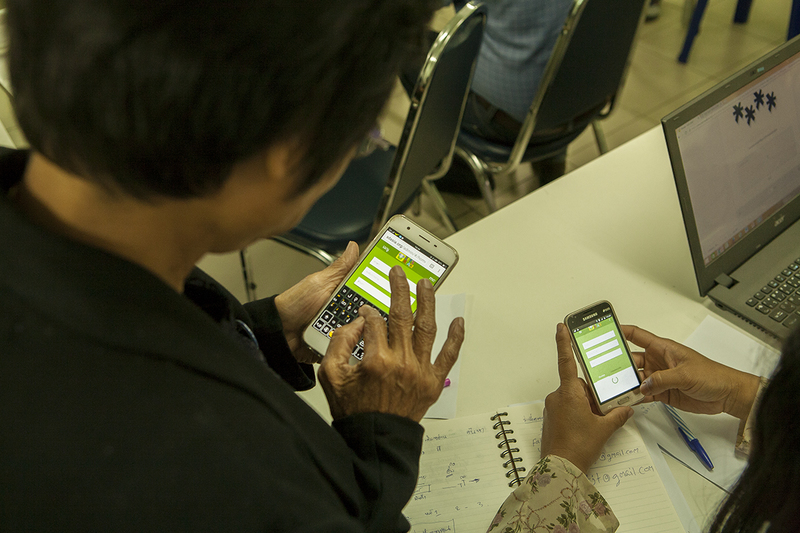
Participants at the ChiangMai workshop. Images courtesy Kyle Barker, The Asia Foundation.
You can read the Khmer translations uploaded by The Asia Foundation here. Keep following us on twitter for more updates about our work with them.
Be the first to comment.